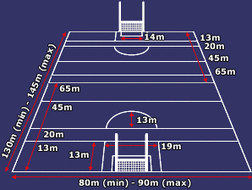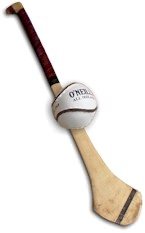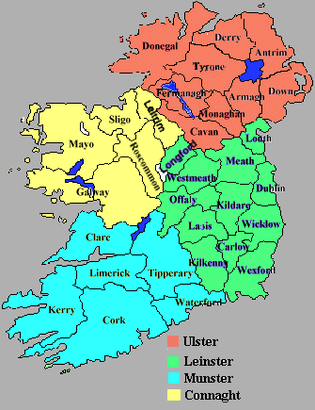We were delighted to find our website has attracted some international followers. As a result we decided to put together this primer to help explain gaelic games to an international audience.
The Games of Gaelic Football and Hurling

Gaelic football is a 15-a-side invasive team sport played with a ball of similar dimensions as that of Association Football (or Soccer). The playing area is rectangular-shaped playing area with dimensions of 130-145m in length and 80-90m wide. The scoring area is H-shaped goalpost with the vertical posts 6.5m apart and the horizontally bar at a height of 2.5m above the ground. A team is awarded one point if it succeeds in getting the ball to cross the scoring zone above the crossbar and the team is awarded three points (called a goal) if it succeeds in getting the ball to cross the scoring zone below the crossbar. The team with the highest combined total of goals and points at the end of the game is deemed the winner. Players can hold the ball in their hand(s) for up to four steps before they must play it against the ground or their foot while retaining possession or they can transfer it by striking it with their hand or foot.
The game has changed over time. For example, the number of scores per game has increased. One hundred years ago, there were 11 scores in the 1912 All-Ireland final. Ten years later there were 10 scores in the 1922 All-Ireland final. By contrast the 2002 and 2012 finals had 27 and 26 scores respectively.
The game has changed over time. For example, the number of scores per game has increased. One hundred years ago, there were 11 scores in the 1912 All-Ireland final. Ten years later there were 10 scores in the 1922 All-Ireland final. By contrast the 2002 and 2012 finals had 27 and 26 scores respectively.

Hurling is similar to gaelic fooball in many ways. Both are 15-a-side invasive team sports. Both have identical playing areas, scoring zones, and scoring methods. However, hurling is a stick and ball game. The ball is similar in size to a baseball or hockey ball but slightly lighter and has small rims on it. Hurling is played with a hockey/shinty style stick that has a larger striking area of approximately 15cm wide at its widest point and striking of the ball is permitted with both sides of the stick. The length of the stick depends on the height of the player. It is usual for adult player to have a hurley stick of 35 inches or so. Players can hold the ball in their hand for up to four steps before they must play it against the stick. Players can only retain position by playing it from hand-to-stick-to-hand once – although the ball can remain balanced on the stick before being transferred back to the hand.
Hurling has also changed over time. Using the same metric as for gaelic football it is possible to see how the changes have mapped into scores. There were 7 (seven) scores in the 1912 final. It rose to 16 scores in the 1922 final. In the 2002 final there were 41 scores and there were 39 scores in the 2012 final replay.
Hurling has also changed over time. Using the same metric as for gaelic football it is possible to see how the changes have mapped into scores. There were 7 (seven) scores in the 1912 final. It rose to 16 scores in the 1922 final. In the 2002 final there were 41 scores and there were 39 scores in the 2012 final replay.
The County Teams

The governing body with responsibility for gaelic football and hurling is the Gaelic Athletic Association (GAA). The core unit of the GAA is the club that represents a relatively small geographical area. The island of Ireland is just over 32,500 square miles and there are 2,163 clubs. This gives an average size of 15 square miles per club but in urban areas it is much smaller.
With relatively rare exceptions the members of the club team have to reside within the club’s geographical area. Club players may be selected to play for the county team. In doing so the represent the county.
The most popular games and teams in the GAA are county teams. Inter-county GAA is organised along representative lines in a manner similar to that of international sport. There are 32 county teams on the island of Ireland as can be seen in Figure 1. The 32 counties can be grouped into 4 provinces. The provinces are Connacht, Leinster, Munster and Ulster. These are also presented in Figure 1.
County teams compete for provincial and All-Ireland honours. For example, the Munster football championship involves the representative teams from Clare, Cork, Kerry, Limerick, Tipperary and Waterford.
With relatively rare exceptions the members of the club team have to reside within the club’s geographical area. Club players may be selected to play for the county team. In doing so the represent the county.
The most popular games and teams in the GAA are county teams. Inter-county GAA is organised along representative lines in a manner similar to that of international sport. There are 32 county teams on the island of Ireland as can be seen in Figure 1. The 32 counties can be grouped into 4 provinces. The provinces are Connacht, Leinster, Munster and Ulster. These are also presented in Figure 1.
County teams compete for provincial and All-Ireland honours. For example, the Munster football championship involves the representative teams from Clare, Cork, Kerry, Limerick, Tipperary and Waterford.
Inter-County Competitions
The primary competitions in gaelic games are single game elimination tournaments (or cup competitions). The pairings for provincial games are sometimes decided by open draw and other times by seeded draws.
Prior to 1997 only provincial winners qualified for the All-Ireland series. In gaelic football, the four provincial winners competed in the All-Ireland semi-finals. The All-Ireland series in hurling was more complicated because of the lack of hurling in Ulster and Connacht counties. Sometimes there were four semi-finalists as in football. Other times there were only three or two provincial winners. In the latter case both team went directly to the All-Ireland final.
The pairings for All-Ireland competitions have tended to be done on a rotational basis. For example, the Munster football champions are seeded to play the other provincial winners every third year.
While teams also play leagues, these leagues are deemed of secondary importance by virtually all members of the association.
The primacy of the cup competitions is probably a function of the power structure of the organisation and its amateur principle. In his book Playbooks and Checkbooks Stefan Symanski (2009) argues that traditionally fans prefer elimination tournaments but that these preferences held less sway as teams gained more power and sought ‘fixity of fixtures’ that leagues provided. He suggests that this is the main reason that the competitions for professional team sports are organised on a league basis whereas individual (non-team) sports, where the competitors have less power, tend to be organised using elimination tournaments.
There were dramatic changes in the qualification for the All-Ireland series in 1996 (hurling), 2001 (football) and 2002 (hurling). Basically, the change involved ALL teams qualifying for the All-Ireland series with the Provincial championship determining the stage at which teams entered. For example, post-2001 provincial winners in football enter the All-Ireland series at the quarter-final stage whereas previously they entered at the semi-final stage. A team beaten in the first round of their provincial football championship enters round 1 of the All-Ireland series.
In many ways the representative nature of the games require the primacy of the elimination tournament. While it is rare, it is not uncommon for a good young player to be a member of 10 teams or more. A good 17-year old might be a member of their club u-18, u-21, and adult teams in both hurling and gaelic football. This is six teams. They might represent their county in both sports at u-18. The total is now eight. They will probably also play with their school teams in both codes. Now they are playing on ten different teams. To facilitate the completion of the competitions for these teams the player will play very few league games. Where the player’s teams are successful then there is fixture congestion because the GAA facilitate the player in all championship competitions by scheduling gaps between games. The whole system survives because of (i) the smaller number of games teams play on average in cup competitions, and (ii) the fact that 50% of the teams will be eliminated at each round.
Prior to 1997 only provincial winners qualified for the All-Ireland series. In gaelic football, the four provincial winners competed in the All-Ireland semi-finals. The All-Ireland series in hurling was more complicated because of the lack of hurling in Ulster and Connacht counties. Sometimes there were four semi-finalists as in football. Other times there were only three or two provincial winners. In the latter case both team went directly to the All-Ireland final.
The pairings for All-Ireland competitions have tended to be done on a rotational basis. For example, the Munster football champions are seeded to play the other provincial winners every third year.
While teams also play leagues, these leagues are deemed of secondary importance by virtually all members of the association.
The primacy of the cup competitions is probably a function of the power structure of the organisation and its amateur principle. In his book Playbooks and Checkbooks Stefan Symanski (2009) argues that traditionally fans prefer elimination tournaments but that these preferences held less sway as teams gained more power and sought ‘fixity of fixtures’ that leagues provided. He suggests that this is the main reason that the competitions for professional team sports are organised on a league basis whereas individual (non-team) sports, where the competitors have less power, tend to be organised using elimination tournaments.
There were dramatic changes in the qualification for the All-Ireland series in 1996 (hurling), 2001 (football) and 2002 (hurling). Basically, the change involved ALL teams qualifying for the All-Ireland series with the Provincial championship determining the stage at which teams entered. For example, post-2001 provincial winners in football enter the All-Ireland series at the quarter-final stage whereas previously they entered at the semi-final stage. A team beaten in the first round of their provincial football championship enters round 1 of the All-Ireland series.
In many ways the representative nature of the games require the primacy of the elimination tournament. While it is rare, it is not uncommon for a good young player to be a member of 10 teams or more. A good 17-year old might be a member of their club u-18, u-21, and adult teams in both hurling and gaelic football. This is six teams. They might represent their county in both sports at u-18. The total is now eight. They will probably also play with their school teams in both codes. Now they are playing on ten different teams. To facilitate the completion of the competitions for these teams the player will play very few league games. Where the player’s teams are successful then there is fixture congestion because the GAA facilitate the player in all championship competitions by scheduling gaps between games. The whole system survives because of (i) the smaller number of games teams play on average in cup competitions, and (ii) the fact that 50% of the teams will be eliminated at each round.
To appreciate it all the more...
Some video clips highlighting the skills of hurling and gaelic football.